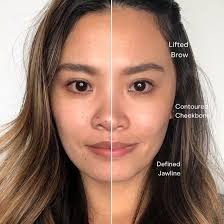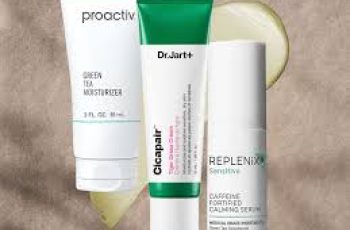
Do Microcurrent Facial Devices Really Work?
Microcurrent facial devices are trending beauty gadgets that claim to be able to reduce fine lines and wrinkles on your face. NuFace, one of the most popular microcurrent brands, offers several devices designed for specific areas and purposes, including a body contouring option. But before you splurge on one of these devices, take a look at the science behind them to help you decide if they’re worth trying.
At-home microcurrent facial devices may smooth lines and wrinkles by increasing cell energy to promote collagen.
At-home microcurrent facial results are temporary, lasting a few days.
Microcurrent facial devices can be worth trying, but they aren’t a replacement for anti-aging skin care.
What Is a Microcurrent Facial?
A microcurrent facial uses low-level electrical currents to stimulate your facial muscles and skin, mimicking your body’s natural electrical activity. Microcurrent technology was first used as a physical therapy treatment in the 1970s to treat facial paralysis and improve muscle function. Over time, doctors noticed that microcurrent treatments were also able to signs of skin aging, helping this technology to gain traction for cosmetic purposes, too.
Initially, microcurrent facials were exclusively offered in clinical and spa settings, where dermatologists used professional-grade machines to deliver precise electrical pulses, targeting specific facial muscles to lift, sculpt, and improve skin firmness. These in-office treatments quickly became a favorite among celebrities and beauty enthusiasts for their skin-lifting effects, sometimes referred to as a “non-surgical facelift.”
In 2005, NuFace became the first brand to introduce FDA-cleared at-home microcurrent facial devices, making this same technology available in the comfort of your home. While these devices use lower intensities of microcurrents than the medical-grade devices, many people report seeing similar benefits with consistent use of at-home devices.
The Science Behind Microcurrents for Your Skin
Microcurrent therapy uses very gentle electrical currents – typically below 1 milliampere (mA) –to work on your skin and the muscles underneath. These currents mimic the natural electrical signals in your body, which are crucial for processes like skin repair, muscle repair, and cell regeneration.
Microcurrents are effective because they follow a scientific principle called the Arndt-Schulz Law . This rule says that small amounts of stimulation can encourage biological activity, while strong stimulation can actually slow it down. Microcurrent devices are designed to deliver just the right amount of electricity to spark positive changes in the skin and muscles without causing any irritation.
Most notably, microcurrent facial devices work by improving the way that mitochondria (the powerhouses of your cells) function. This, in turn, increases the production of ATP (adenosine triphosphate) , the energy source for all cells and a key component in the creation of proteins like collagen and elastin in your skin. Researchers have found that microcurrent can increase ATP levels by up to 500% (3).
Microcurrent facial devices can also improve blood flow and overall circulation, delivering more oxygen and nutrients to your skin cells. This may help to promote a healthy, glowing complexion.
What Does the Research Say?
The bulk of research on microcurrent therapy is in the context of medical and physical therapy uses. While there is emerging research that shows promising evidence of the anti-aging benefits behind at-home microcurrent facial devices, many of these studies are small.
More large-scale trials are needed to confirm the specific effects of microcurrent on aging skin, especially with at-home devices.
That said, key findings from the current research include:
Facial muscle toning. Studies show that microcurrent can gently stimulate facial muscles to improve tone and lift. It’s like a “workout” for your face, helping to sculpt and firm the contours over time (3).
Faster healing. Clinical research has shown that microcurrent therapy accelerates wound healing and skin repair by encouraging skin cells to migrate to the damaged area (4).
Anti-aging benefits. Regular microcurrent facial device use has been linked to firmer skin and fewer wrinkles, thanks to its ability to support collagen production and improve skin texture (5).
What Can Microcurrent Facial Devices Treat?
Microcurrent facial devices may improve signs of skin aging such as:
Sagging skin. Provides a subtle lifting effect by stimulating facial muscles.
Fine lines and wrinkles. Boosts collagen production for smoother skin.
Puffiness. Encourages lymphatic drainage for a smoother and more even appearance.
Uneven skin tone. Improved circulation may help to brighten the complexion (6).
Downsides to Microcurrent Facial Devices
Microcurrent facial devices do come with some downsides and may not be for everyone.
Temporary results. Effects typically last for 1 to 3 days and require consistent use for noticeable changes.
Time commitment. Results require daily or regular use.
Cost. Some microcurrent devices can be expensive, costing upwards of $400.
Mild irritation. Some people, especially those with sensitive skin, may experience tingling, redness, or irritation when using microcurrent devices.
Who Shouldn’t Use Microcurrent Facial Devices?
Microcurrent facial devices may not be safe for everyone. Avoid using these devices if you:
Have a pacemaker or other implanted electronic devices.
Are pregnant.
Have epilepsy or a history of seizures.
Recently had Botox or dermal fillers (wait 2 to 3 weeks to prevent moving the product).
Have sensitive skin prone to irritation.
Popular Microcurrent Facial Devices
NuFace is one of the most popular brands for at-home microcurrent facial devices. Some of their bestselling products include:
Bottom Line: Are Microcurrent Facial Devices Worth It?
Microcurrent facial devices like those from NuFace can be a nice-to-have addition to your anti-aging skin care regimen, but they aren’t a must-have. While these devices have a growing body of research to support their anti-aging benefits, they aren’t going to be a replacement for anti-aging ingredients like retinoids, vitamin C, or other antioxidants.
If you’re looking to build an anti-aging skin care regimen but aren’t sure where to start, take the Skin Type Quiz below to find out which of the 16 skin types you are. From there, we can help you customize an anti-aging regimen that’s right for your skin.


